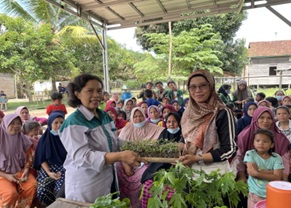Pemanfaatan Limbah Ternak sebagai Media Pembuatan Bioinsektisida Berbahan Aktif Bacillus thuringiensis dalam Mendukung Pengendalian Hama Terpadu Utilization of Livestock Waste as a Medium Producing Bacillus thuringiensis-Bioinsecticides Containing in Supporting Integrated Pest Control
Main Article Content
Abstract
Livestock waste becomes a problem and disturbs the community environment. In addition to the odor generated, it causes an unclean environment. Livestock waste is a problem for the people of Jungkal Village, Pampangan District, Ogan Komering Ilir Regency, South Sumatra. Good environmental management must be a priority. Therefore, livestock waste must be utilized to create a healthy environment. The purpose of this activity was to explain the use of livestock waste as a medium to produce bio-insecticides made from the active Bacillus thuringiensis bacteria. The target community was a farmer group in Jungkal Village. Activities were carried out in two ways, namely socialization activities and practical activities to produce bio-insecticide with active B. thuringiensis. Preliminary data showed that farmers were aware that livestock waste causes discomfort. Handling both liquid and solid waste has yielded little results because, so far, farmers have only gotten rid of this waste without using it as a helpful product. After the community service activities were completed, 80% of the participants understood the benefit of livestock waste. With an intensive approach and assistance, farmer groups can receive new directions.
Downloads
Article Details

This work is licensed under a Creative Commons Attribution-ShareAlike 4.0 International License.
Authors who publish with this journal agree to the following terms:
- Any article on the copyright is retained by the author(s).
- Author grant the journal, right of first publication with the work simultaneously licensed under a Creative Commons Attribution License that allows others to share work with acknowledgment of the work authors and initial publications in this journal.
- Authors are able to enter into a separate, additional contractual arrangements for non-exclusive distribution of published articles of work (eg, post-institutional repository) or publish it in a book, with acknowledgment of its initial publication in this journal.
- Authors are permitted and encouraged to post their work online (e.g., in institutional repositories or on their websites) prior to and during the submission process, as can lead to productive exchanges, as well as earlier and greater citation of published work.
- The article and any associated published material is distributed under the Creative Commons Attribution-ShareAlike 4.0 International License
References
Ali, M. P., Kabir, M. M. M., Haque, S. S., Qin, X., Nasrin, S., et al. (2020). Farmer’s Behavior in Pesticide Use: Insights Study from Smallholder and Intensive Agricultural Farms in Bangladesh. Science of the Total Environment, 747, 141160. https://doi.org/10.1016/j.scitotenv.2020.141160
Bravo, A., Isabel, G., Helena P., Blanca I. G. G., Claudia R.A., Liliana P., et al. (2013). Evolution of Bacillus Thuringiensis Cry Toxins Insecticidal Activity. Microbial Biotechnology, 6(1), 17–26. https://doi.org/10.1111/j.1751-7915.2012.00342.x
Chèze, B., Maia D., & Vincent M. (2020). Understanding Farmers’ Reluctance to Reduce Pesticide Use: A Choice Experiment. Ecological Economics, 167, 106349. https://doi.org/10.1016/j.ecolecon.2019.06.004
Dara, S. K. (2019). The New Integrated Pest Management Paradigm for the Modern Age. Journal of Integrated Pest Management, 10(1), 12. https://doi.org/10.1093/jipm/pmz010
Diratmaja, I. A. & Zakiah. (2015). Konsep Dasar Dan Penerapan PHT Padi Sawah Di Tingkat Petani. Jurnal Pertanian Agros, 17(1), 33–45.
Indiati, S.W. & Marwoto, M. (2017). Penerapan Pengendalian Hama Terpadu (PHT) pada Tanaman Kedelai. Buletin Palawija, 15(2), 87-100. https://dx.doi.org/10.21082/bul/palawija.v15n2.2017.p87-100
Mangungsong A., Soemarsono, & Zudri, F. (2020). Pemanfaatan Mikroba Tanah Dalam Pembuatan Pupuk Organik Serta Peranannya Terhadap Tanah Aluvial Dan Pertumbuhan Bibit Tanaman Kakao. Jurnal Agronomi Indonesia (Indonesian Journal of Agronomy), 47(3), 318-325. https://doi.org/10.24831/jai.v47i3.24721
Martinez, J., Patrick D., Suzelle B., & Colin B. (2009). Livestock Waste Treatment Systems for Environmental Quality, Food Safety, and Sustainability. Bioresource Technology, 100(22), 5527–5536. https://doi.org/10.1016/j.biortech.2009.02.038
Oluwole, O. & Cheke, R. A. (2009). Health and Environmental Impacts of Pesticide Use Practices: A Case Study of Farmers in Ekiti State, Nigeria. International Journal of Agricultural Sustainability, 7(3), 153–163. http://dx.doi.org/10.3763/ijas.2009.0431
Pujiastuti, Y., Gunawan B., Arsi, Suparman, Sulistyani, D. P., & Sandi, S. (2020). Bacillus thuringiensis Propagated in Bio-Urine Media as a Biological Control of Termite Coptotermes curvignathus and Armyworm Spodoptera litura. IOP Conference Series: Earth and Environmental Science, 468, 012009. https://dx.doi.org/10.1088/1755-1315/468/1/012009
Saputro, D. D., Wijaya, B. R., & Yuni, W. (2014). Pengelolaan Limbah Peternakan Sapi untuk Meningkatkan Kapasitas Produksi pada Kelompok Ternak Patra Sutera. Rekayasa: Jurnal Penerapan Teknologi dan Pembelajaran, 12(2), 91–98. https://doi.org/10.15294/rekayasa.v12i2.10124
Sidabutar, V., Marheni, & Lubis, L. (2017). Indeks Keanekaragaman Jenis Serangga pada Fase Vegetatif dan Generatif Tanaman Kedelai (Glycine max Merill) Di Lapangan. Jurnal Agroekoteknologi, 5(2), 474–483.
Wahyuono, D. (2015). Kajian Formulasi Bacillus thuringiensis dengan Carrier Limbah Cair Pabrik Kelapa Sawit untuk Pengendalian Ulat Api (Setora nitens). Planta Tropika: Jurnal Agrosains, 3(1), 24–30. https://doi.org/10.18196/pt.2015.036.24-30
Yuantari, M. G. C, Budi, W., & Henna, R. S. (2013). Tingkat Pengetahuan Petani dalam Menggunakan Pestisida (Studi Kasus Di Desa Curut Kecamatan Penawangan Kabupaten Grobogan). In: Prosiding Seminar nasional Pengelolaan Sumberdaya dan Lingkungan : Optimasi pengelolaan sumberdaya alam dan lingkungan dalam mewujudkan pembangunan berkelanjutan Semarang, 27 Agustus 2013. Semarang: Program Studi Ilmu Lingkungan Program Pascasarjana Universitas Diponegoro: 142–148.
